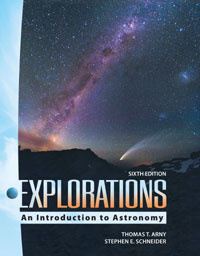 
Explorations: Introduction to Astronomy (Arny), 6th EditionChapter 2:
The Rise of Astronomy  <a onClick="window.open('/olcweb/cgi/pluginpop.cgi?it=jpg::::/sites/dl/free/0010202009/220722/chapter2.jpg','popWin', 'width=NaN,height=NaN,resizable,scrollbars');" href="#"><img valign="absmiddle" height="16" width="16" border="0" src="/olcweb/styles/shared/linkicons/image.gif"> (169.0K)</a> <a onClick="window.open('/olcweb/cgi/pluginpop.cgi?it=jpg::::/sites/dl/free/0010202009/220722/chapter2.jpg','popWin', 'width=NaN,height=NaN,resizable,scrollbars');" href="#"><img valign="absmiddle" height="16" width="16" border="0" src="/olcweb/styles/shared/linkicons/image.gif"> (169.0K)</a> | |
- Gravity controls the motion of most astronomical objects.
- If no forces act on an object, inertia keeps it moving in a straight line at a constant speed.
- If an object is not moving along a straight line at a constant speed, a force must be acting on it.
- Newton’s laws of motion allow us to describe and predict an object's motion if we know the forces acting on it.
- The force of gravity between two objects depends on their mass and the distance between them:
- The greater their separation, the weaker the force.
- The greater their mass, the greater the force.
- Orbital motion allows us to determine the mass of (“weight”) astronomical objects.
|
 |  |
|





